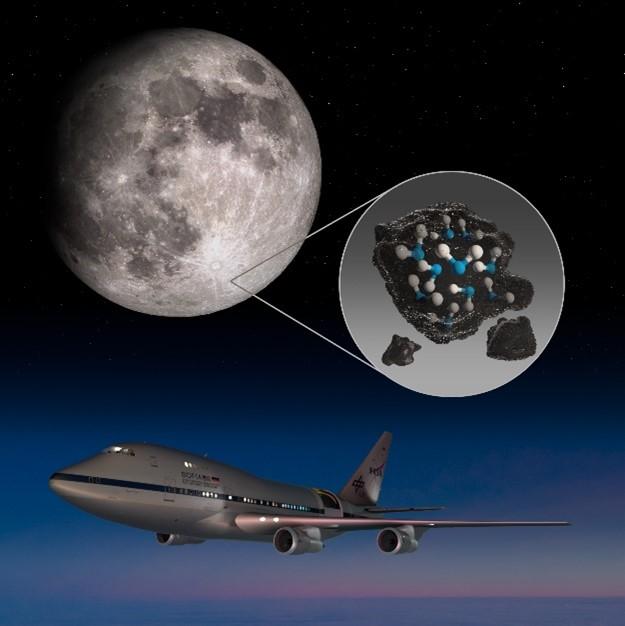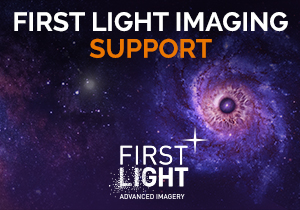26 Oct
NASA’s Flying Observatory SOFIA discovers water on the Moon
On 26th October, NASA announced the discovery of molecular water (H2O) on the lunar surface based on a recently published article in Nature Astronomy1 by first-author C.I. Honniball and collaborators.
This discovery is a result of lunar observations using the NASA/DLR Stratospheric Observatory for Infrared Astronomy2 (SOFIA) and the Faint Object InfraRed Camera for the SOFIA Telescope3 (FORCAST) instrument.
Another instrument on-board SOFIA, the so-called Focal Plane Imager4 (FPI+), utilises an Andor iXon5 EMCCD. The FPI+ operates at optical wavelengths and is mainly used as tracking and high-speed imaging camera. Thus, it can be used to support the FORCAST instrument, which was used to confirm the existence of water on the lunar surface during an observing run.
In the future, SOFIA’s Wide-Field-Imager6 (WFI) and Fine-Field-Imager6 (FFI) are each going to be upgraded with a customised version of the iXon EMCCD.
Dr Andrew Dennis, Director of Product Management at Andor, commented:
“At Andor, we are proud that our high-performance cameras are part of outstanding research facilities such as SOFIA, contributing to breakthrough discoveries such as finding water on the Moon that may lead to a step-change in humanity’s ability to explore the solar system.”
SOFIA – The Flying Observatory and its instruments
SOFIA is a modified Boeing 747-SP aircraft hosting a 2.5m telescope and flying at an altitude around ~11-13.5 km. This allows the ‘flying observatory’ to conduct observations above 99% of the Earth’s infrared blocking atmosphere, making it ideal for studies of the infrared Universe ranging from transient events to studies of solar system objects and beyond.
SOFIA also offers a wide range of telescope instruments, which includes detectors, polarimeters and spectrometers. An example is the FORCAST instrument, which is a two channel mid-infrared instrument with sensitivities from 5-40 μm. It is comprised of a Short Wave Camera (SWC; optimized for λ < 25 μm), a Long Wave Camera (LWC; optimized for λ > 25 μm) and a spectrograph.
The discovery of H2O on the lunar surface with SOFIA
The researchers conducted lunar observations at 6 μm - a wavelength, which the FORCAST instrument is ideally suited for. This specific wavelength was selected as it corresponds to a fundamental vibration of molecular water and thus, the detection of a spectral signature at 6 μm can reveal the existence of H2O on the lunar surface. The team’s analysis of the FORCAST data confirmed the presence of this 6 μm emission feature, which was observed at high southern latitudes (i.e.: at the so-called “Clavius crater”, a large crater visible from Earth, and its surrounding area). Further analysis showed that the estimated concentration of water in this area is between 100 to 412 parts per million, which roughly corresponds to a 12-ounce water bottle7.
This discovery is important for several reasons:
i) It confirms, for the first time, the existence of molecular water on the Moon’s surface. Previous lunar observations showed the presence of some form of hydration on its surface, but it was unknown whether the measurements referred to water (H2O) or other hydroxyl (OH) compounds.
ii) This indicates that water may be distributed across the Moon’s surface.
iii) Important questions have been raised on how water can persist and how it is created on the lunar surface.
iv) The presence of H2O on the Moon could be of relevance for future deep space exploration.

Figure 1 - This illustration highlights the Moon’s Clavius Crater with an illustration depicting water trapped in the lunar soil, along with an image of NASA’s Stratospheric Observatory for Infrared Astronomy (SOFIA) that found sunlit lunar water. Credits: NASA
To further investigate this finding, there are plans for SOFIA to conduct follow-up observations to look for H2O in other locations. In addition, NASA’s Artemis program will aim to learn as much as possible about H2O on the Moon and how it may support long-term exploration.
Further information and reading:
1. Nature article: https://www.nature.com/articles/s41550-020-01222-x#Abs1
2. SOFIA: https://www.nasa.gov/mission_pages/SOFIA/index.html
3. FORCAST: https://www.sofia.usra.edu/science/instruments/forcast
4. FPI+: https://www.sofia.usra.edu/science/instruments/fpi
5. Andor iXon EMCCD Cameras: https://andor.oxinst.com/products/ixon-emccd-cameras
6. SOFIA Guide cameras: https://www.sofia.usra.edu/science/instruments/guider-cameras
7. NASA Press Release: https://www.nasa.gov/press-release/nasa-s-sofia-discovers-water-on-sunlit-surface-of-moon/
8. Press release in German from DSI: https://www.dsi.uni-stuttgart.de/institut/aktuelles/news/Fliegende-Sternwarte-SOFIA-entdeckt-molekulares-Wasser-auf-dem-Mond/




